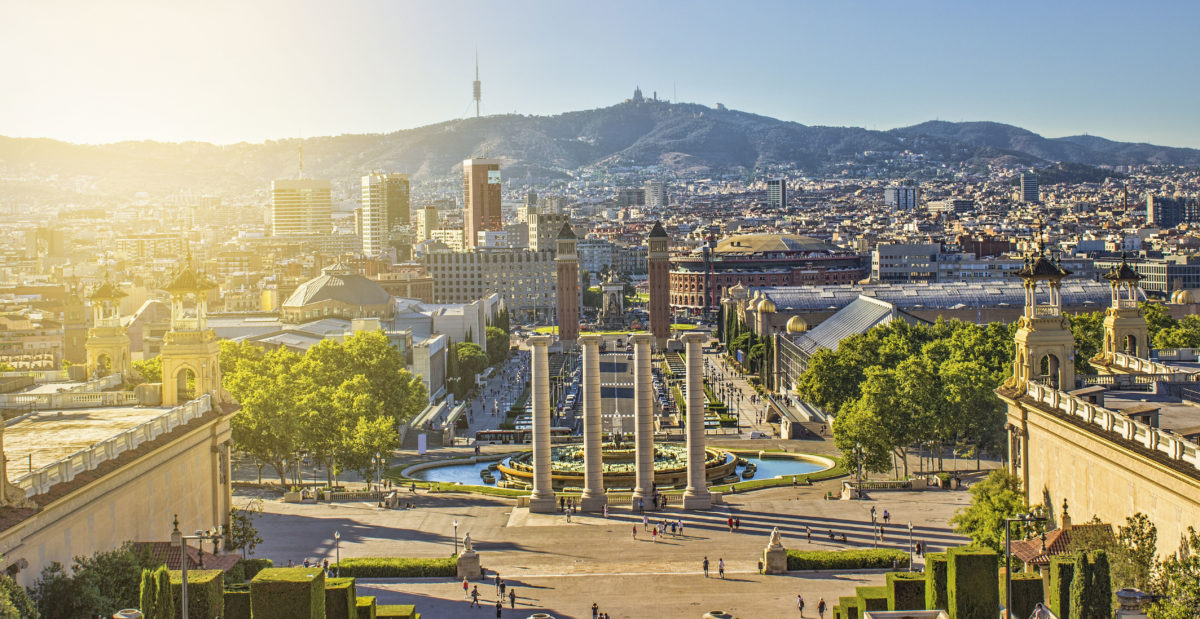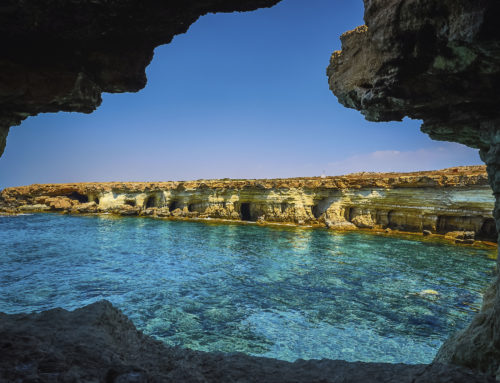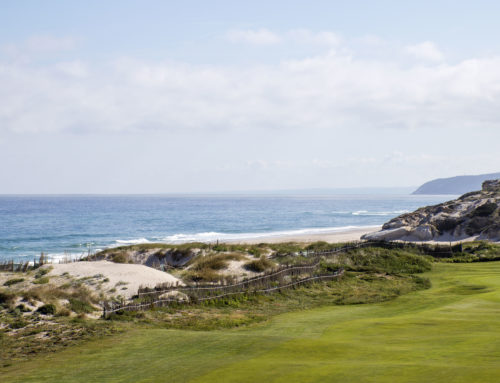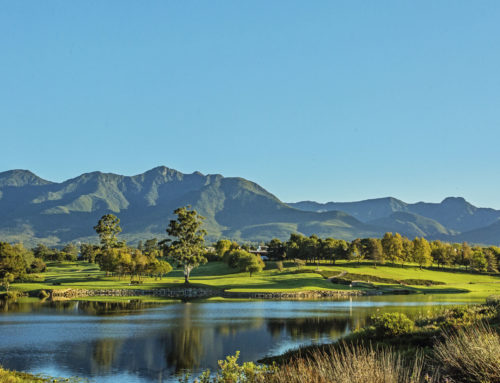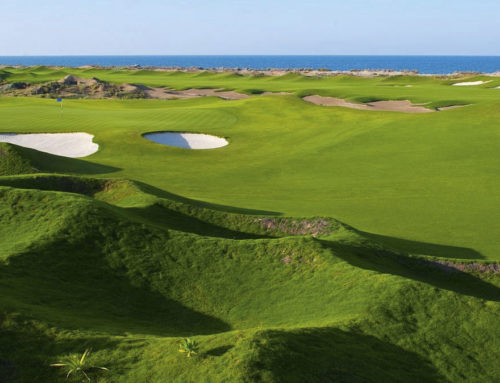FOR CITY LOVERS
Spain is not short of thrilling cities. Seville seduces with its mix of resplendent Mudéjar palaces, baroque churches and medieval lanes, Madrid is rich in artistic heritage and has a legendary nightlife while Valencia, Malaga and Bilbao are all fantastic places to visit.
However, for golfers seeking a heady hit of urban energy, while based within easy striking distance of amazing golf, Barcelona is difficult to beat.
Set on a plain rising gently from the Mediterranean Sea, the capital of Catalonia is Spain’s most cosmopolitan city and is renowned for its incredible culture, architecture and world-class dining and drinking scene.
There are almost too many highlights for visitors to take in on just one visit. For instance, art lovers can pay homage to masters like Pablo Picasso and Joan Miró at their respective museums.
Synonymous with the city is architect Antoni Gaudí, whose highly-individualised style can be appreciated at numerous sites including — most famously — the spectacular, still unfinished Sagrada Familia.
Given the abundance of sights and attractions — not to mention an abundance of restaurants and bars — it seems almost masochistic to indulge in sporting distraction. Nevertheless, some of the best layouts in Spain are nearby, so it’s worth making the effort.
Close to the city, the Real Club de Golf El Prat (green fees from £72) is a regular host of major tournaments such as the Spanish Open. Formerly sited near Barcelona’s main airport, the club shifted north to its present location and brought in Australian legend Greg Norman to design two excellent 18-hole layouts.
A little further north still, near the city of Girona (but still only around an hour from Barcelona) is the PGA Catalunya Resort (green fee from £65). The resort has another incredible course — the Tour — but it is overshadowed by the Stadium layout, which has been ranked as one of Europe’s very best courses since opening at the end of 1998.
FOR WINE LOVERS
Oenophile golfers are spoiled for choice in Spain. Like France, large swathes of the nation have perfect conditions for vine cultivation. The prevalence of wine in Spanish drinking and dining culture means that visitors will always be able to sample an excellent bottle or three following a round of golf.
There’s some extremely good golf to be enjoyed in some of the country’s most fabled wine producing areas. One of the best places to combine some excellent play with vineyard visits and several copas (glasses) of the local specialty is La Rioja.
Located just south of the Basque region in the north of the country, La Rioja is one of Spain’s unsung gems with lush river valleys, rugged highlands and verdant rolling countryside characterising the scenery.
The area is justifiably famous for its vineyards and offers ample scope for winery visits. Some of the best options include Bodegas Muga, Bodegas Ysios and Bodegas Marques de Riscal — one of La Rioja’s oldest wineries that fuses old and new with a futuristic hotel designed by legendary architect Frank Gehry.
While golf, almost inevitably, plays second fiddle to the sacred grape, La Rioja is no slouch when it comes to offering superb (and often challenging) holiday golf. Most of the best courses are located within easy range of the provincial capital Logroño.
Rioja Alta Golf Club (green fees from £45) is laid out across a serene, gently undulating landscape. While the setting is idyllic, ponds and wetland areas come into play at half-a- dozen holes, which makes this attractive course a fine test of skill.
Another must-play option in the wine country of La Rioja is Sojuela Club de Campo La Rioja (green fees from £45), which was designed by Seve Ballesteros. Laid out amid stunning scenery, the course is a visual treat and play highlights include the par-5 18th, which plunges steeply downhill to the clubhouse.
FOR LOVERS OF HIKING
Tenerife ticks several boxes for golfers. The grand dame of the Canaries archipelago has long been a favourite with visiting Brits, and for good reason.
Its famous southern resorts offer white sand beaches, all-inclusive resorts and plenty of revelry while the lovely year-round climate makes it a no-brainer for northern Europeans seeking out an extended hit of rejuvenating sun. Throw into the mix a clutch of sterling layouts and it’s easy to see why it has a reputation as such a solid golf destination.
The island, though, is far more than just a reliable standby for a winter beach and golf break. It is especially well-suited to hiking, with its rugged volcanic topography offering some of the most thrilling walking routes in Europe. Over 600 miles of trails weave through rich woodland, traverse deep gullies and curve up, over and around volcanic peaks.
Top hikes include the walk through Masca Gorge, while the pine-scented forests near Los Órganos offer a lush counterpoint to the moonscapes elsewhere. The zenith for many visiting hikers, meanwhile, is scaling the summit of 12,198ft Mount Teide — the snow-dusted highest point in Spain.
Less taxing on the legs, but a challenge for anyone’s golf skills are the island’s clutch of layouts. One of the most reliable options is Golf del Sur (green fees from £52). Here, 27 holes weave round ravines and volcanic sand traps and dip towards the sea. There are numerous choice holes, including the par-3 2nd on the South nine, which is known as the ‘fried egg’ due to the sand that surrounds the green.
Equally appealing is Amarilla Golf Tenerife (green fees from £66). Rated by some as the best course on the island, the layout unfolds towards the ocean and possesses several excellent holes.
Handily positioned between the two clubs is Hotel Aguamarina Golf, which features luxurious accommodation and a stunning pool overlooking the ocean.
FOR HISTORY LOVERS
Spain’s cities are replete with palaces, gothic cathedrals and other venerable sites, while the entire country is dotted with ancient towns where a sense of the past is palpable. However, the part of the nation with the most bulging historic treasure trove is Andalucía, which also just happens to be prime territory for golfers.
The sizzling southern region, immortalised in operas and depicted vividly in 19th-century art and literature, is arguably Spain’s most evocative.
Mountains as bone-dry as the region’s famous sherry are home to the Iberian lynx, ibex and bearded vulture, while dusty villages and towns with their buzzing tapas bars and flamenco clubs could all come straight from a play by Federico García Lorca.
Andalucía’s showpiece historic sights are on a far grander scale than the average time-warped settlement. The region’s unique lineage as a frontier zone between Christianity and Islam has bequeathed it some of the world’s most spectacular examples of ancient architecture.
Show-stopping historical draws in the region include the centre of Córdoba where the city’s Moorish heritage is best represented by its stunning Mosque-Cathedral. Other big-hitters, meanwhile, include the Alhambra — a giant palace complex near the city of Granada — and the Real Alcázar in Seville, the oldest royal palace still in use in Europe.
As well as being an excellent place for history buffs to spend a holiday, Andalucía is also well-known as a magnet for golfers: with fantastic layouts and famous golf resorts extending all the way along its coast as well as inland.
The most prestigious club in Andalucía is probably Real Club Valderrama (green fees from £315). Nicknamed the ‘Augusta of Europe’, it has hosted a plethora of championships including the Volvo Masters and the Ryder Cup. Never overplayed, the course is always in great condition and holes such as the 17th, a par-5 with water in front of the green, are central to its status as one Spain’s best courses.
Almost as famous as Valderrama is Montecastillo (green fees from £85), one of the most popular golf resorts in the world. Routed thoughtfully across rolling terrain by its designer, the venerable Jack Nicklaus, the course offers spectacular views and a great selection of testing holes.
FOR FOOD LOVERS
Castilians would parlay their grilled and roast meats, Catalans their bounty of vegetables, while Valencians are likely to swear by their native version of the paella. Fantastic regional cuisines can be discovered and devoured from the Atlantic coast of Galicia in the far north west to the tapas bars of Andalucía. Eating often and well is truly part of the joy of travelling around Spain for food-obsessed golfers.
In recent times, though, the Basque Country in northern Spain has emerged pre-eminent among the nation’s gastronomic destinations. San Sebastián, a coastal city near the border with France, is particularly alluring for gourmet travellers. Home to countless Michelin-star restaurants, fresh markets and produce shops, the city is regarded by many as the food capital of the planet.
While eating out at one of the city’s top fine dining venues is an obvious highlight, another must-try is the Basque-style pintxos for which San Sebastián is famed. Small pieces of bread are topped with a variety of different ingredients — anything from Spanish ham to cheese, chorizo and wild mushroom croquettes — and are speared with sticks and placed along the bar for diners to come and help themselves.
For golfers visiting San Sebastian, a round of golf at Real Golf Club de San Sebastian (green fees from £36) is every bit as appetising as the local fare. The home club of Ryder Cup legend Jose Maria Olazabal, the beautiful, forested course is laid out on hilly terrain beside Mount Jaizkibel.
Further west along the north coast from the Basque Country is the region of Cantabria, famous for its fantastic sea food and for freshwater salmon and trout from the upper basins of the many rivers that empty in the Cantabrian Sea.
The coastline is less abundant in golf courses than it is seafood. Nevertheless, the layout at Real Golf de Pedrena (green fees from £90) is a thing of real beauty. Famous for being the home course of Seve Ballesteros, Pedrena was originally laid out by Harry Colt in 1928 on an undulating wooded peninsula jutting into the Bay of Santander.
FOR BEACH LOVERS
With more than 5,000 miles of coastline, it’s not a question of where to find a stretch of sand in Spain, it’s which stretch of sand to opt for.
And with championship golf courses and stunning golf resorts edging onto beaches everywhere from Andalucía in the south to Catalonia in the north east, there’s no end of enticing options for golfers looking to divide their time between the links and the sun lounger.
But while every coastal region in Spain has its aficionados, few would quibble with the beauty of the beaches on the Balearic Islands.
Especially popular with holiday golfers is Majorca, the largest of the four islands that comprise the sun-kissed archipelago. A long-standing favourite of package tourists, Majorca is well geared to visitors, with countless fine resorts and dining and drinking options that range from traditional Spanish bodegas to English-style pubs offering pies and fish suppers.
However, Majorca has not traded its soul in exchange for tourist money. Its stunning coast offers everything from cliff-sculpted coves to bone-white beaches.
Majorca is also rich in golfing territory. The island’s best course, Golf Son Gual (green fees from £90), is also one of its freshest. The brainchild of German businessman Adam Pamer, who invested millions turning a bland slice of former agricultural land into a world-class golf course, the layout features expansive bunkering, acres of water and one of Europe’s most dramatic closing hole in its 18th.
Nearby, Golf Park Mallorca-Puntiró (green fees from £72) is another fine test on the outskirts of Palma, the island’s bustling capital. The work of the Nicklaus Design stable, the layout features pine and olive tree-lined fairways and some serious excitement at its water feature holes which all incorporate cunning risk and reward elements.
FOR FESTIVAL LOVERS
Colourful and lively festivals and fiestas light up the calendar throughout Spain. The country’s epicentre when it comes to staging unforgettable events is Valencia — home to some of the nation’s most memorable annual shindigs.
From civilised culinary meets where the city’s famously rich dining scene is celebrated to tomato and fireworks fights and other no-holds-barred parties, Valencia offers several opportunities throughout the year for visiting golfers to let their hair down.
The most storied of Valencia’s jamborees is undoubtedly Las Fallas, which takes place every March. Elaborate figures made from wood and papier-mâché are paraded around the city during the week leading up to the festival then set ablaze at midnight on the last day.
The atmosphere during the festival is electric with mobile discos, outdoor concerts and street parties attracting huge crowds.
Equally fascinating are events such as La Tomatina when tens of thousands of people travel to the small town of Buñol, just outside the city to take part in a huge annual tomato fight.
Other carnivals to look out for are the Ferias de Julio, which take place throughout July, and La Corda de Paterna, a fireworks festival held at the end of August.
Also highly celebrated are the golf courses near Valencia and further south in the region of Murcia. The best of the bunch is probably Campo de Golf El Saler (green fees from £88), one of the jewels in Spain’s golfing crown. Designed by Spanish architect Javier Arana, the course is routed across varied terrain with some holes flanked by umbrella pines and others by towering sand dunes.
Another gem not too far from Valencia is the course at Las Colinas (green fees from £64) on the Costa Blanca. A relatively young layout designed by Cabell Robinson, the course features generous fairways. But these are tempered by the presence of heavy bunkering and undulating and speedy putting surfaces.

